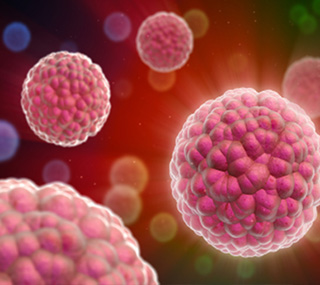Ovarian cancer
Ovarian epithelial cancer is a disease in which malignant (cancer) cells form in the tissue covering the ovary.
The ovaries are a pair of organs in the female reproductive system. They are located in the pelvis, one on each side of the uterus (the hollow, pear-shaped organ where a fetus grows). Each ovary is about the size and shape of an almond. The ovaries produce eggs and female hormones (chemicals that control the way certain cells or organs function).
The close collaboration among our doctors and our research scientists means that new drugs and treatments developed in the laboratory can quickly move to the clinic, offering our patients immediate access to the latest therapies. For example, our physician-scientists are looking for a blood marker that would allow early detection of ovarian cancer. We were also instrumental in the development of the liquid Pap test.

Pelvic exam: An exam of the vagina, cervix, uterus, fallopian tubes, ovaries, and rectum. The doctor or nurse inserts one or two lubricated, gloved fingers of one hand into the vagina and the other hand is placed over the lower abdomen to feel the size, shape, and position of the uterus and ovaries. A speculum is also inserted into the vagina and the doctor or nurse looks at the vagina and cervix for signs of disease. A Pap test or Pap smear of the cervix is usually done. The doctor or nurse also inserts a lubricated, gloved finger into the rectum to feel for lumps or abnormal areas.
Ultrasound exam: A procedure in which high-energy sound waves (ultrasound) are bounced off internal tissues or organs and make echoes. The echoes form a picture of body tissues called a sonogram. The picture can be printed to be looked at later. An abdominal ultrasound or a transvaginal ultrasound may be done.
- Abdominal ultrasound: An ultrasound transducer connected to a computer is passed over the surface of the abdomen. The ultrasound transducer bounces sound waves off internal organs and tissues to make echoes that form a sonogram (computer picture).
- Transvaginal ultrasound: An ultrasound probe connected to a computer is inserted into the vagina and is gently moved to show different organs. The probe bounces sound waves off internal organs and tissues to make echoes that form a sonogram (computer picture).
CA 125 assay: A test that measures the level of CA 125 in the blood. CA 125 is a substance released by cells into the bloodstream. An increased CA 125 level is sometimes a sign of cancer or other condition.
Barium enema: A series of x-rays of the lower gastrointestinal tract. A liquid that contains barium (a silver-white metallic compound) is put into the rectum. The barium coats the lower gastrointestinal tract and x-rays are taken. This procedure is also called a lower GI series.
Intravenous pyelogram (IVP): A series of x-rays of the kidneys, ureters, and bladder to find out if cancer has spread to these organs. A contrast dye is injected into a vein. As the contrast dye moves through the kidneys, ureters, and bladder, x-rays are taken to see if there are any blockages.
CT scan (CAT scan): A procedure that makes a series of detailed pictures of areas inside the body, taken from different angles. The pictures are made by a computer linked to an x-ray machine. A dye may be injected into a vein or swallowed to help the organs or tissues show up more clearly. This procedure is also called computed tomography, computerized tomography, or computerized axial tomography.
Biopsy: The removal of cells or tissues so they can be viewed under a microscope by a pathologist to check for signs of cancer. The tissue is removed in a procedure called a laparotomy (a surgical incision made in the wall of the abdomen).
Sources: National Cancer Institute and UC Davis Comprehensive Cancer Center
Early ovarian cancer may not cause any symptoms. When symptoms do appear, ovarian cancer is often advanced. Symptoms of ovarian cancer may include the following:
- Pain or swelling in the abdomen
- Pain in the pelvis
- Gastrointestinal problems, such as gas, bloating, or constipation
These symptoms may be caused by other conditions and not by ovarian cancer. If the symptoms get worse or do not go away on their own, a doctor should be consulted so that any problem can be diagnosed and treated as early as possible. When found in its early stages, ovarian epithelial cancer can often be cured.
Sources: National Cancer Institute and UC Davis Comprehensive Cancer Center
- A woman whose mother or sister had ovarian cancer has an increased risk of ovarian cancer. A woman with two or more relatives with ovarian cancer also has an increased risk of ovarian cancer. The risk of ovarian cancer is increased in women who have inherited certain changes in BRCA1 or BRCA2 genes.
- The use of estrogen-only hormone replacement therapy (HRT) after menopause increases the risk of ovarian cancer. The longer estrogen replacement therapy is used, the greater the risk may be. It is not clear whether the risk of ovarian cancer is increased with the use of HRT that has both estrogen and progestin.
- The use of fertility drugs may be linked to an increased risk of ovarian cancer.
- The use of talc may increase the risk of ovarian cancer. Talcum powder dusted on the perineum (the area between the vagina and the anus) may reach the ovaries by entering the vagina.
- Having too much body fat, especially during the teenage years, is linked to an increased risk of ovarian cancer. Being obese is linked to an increased risk of death from ovarian cancer.
Sources: National Cancer Institute and UC Davis Comprehensive Cancer Center
Three kinds of standard treatment are used.
- Surgery
- Radiation therapy
- Chemotherapy
New types of treatment are being tested in clinical trials.
- Biologic therapy
- Targeted therapy
Patients may want to think about taking part in a clinical trial and can enter clinical trials before, during, or after starting their cancer treatment. Follow-up tests may be needed.
There are different types of treatment for patients with ovarian epithelial cancer.
Three kinds of standard treatment are used. These include the following:
- Surgery
Most patients have surgery to remove as much of the tumor as possible. Different types of surgery may include:- Total hysterectomy: A surgical procedure to remove the uterus, including the cervix. If the uterus and cervix are taken out through the vagina, the operation is called a vaginal hysterectomy. If the uterus and cervix are taken out through a large incision (cut) in the abdomen, the operation is called a total abdominal hysterectomy. If the uterus and cervix are taken out through a small incision (cut) in the abdomen using a laparoscope, the operation is called a total laparoscopic hysterectomy.
- Hysterectomy: The uterus is surgically removed with or without other organs or tissues. In a total hysterectomy, the uterus and cervix are removed. In a total hysterectomy with salpingo-oophorectomy, (a) the uterus plus one (unilateral) ovary and fallopian tube are removed; or (b) the uterus plus both (bilateral) ovaries and fallopian tubes are removed. In a radical hysterectomy, the uterus, cervix, both ovaries, both fallopian tubes, and nearby tissue are removed. These procedures are done using a low transverse incision or a vertical incision.
- Unilateral salpingo-oophorectomy: A surgical procedure to remove one ovary and one fallopian tube.
- Bilateral salpingo-oophorectomy: A surgical procedure to remove both ovaries and both fallopian tubes.
- Omentectomy: A surgical procedure to remove the omentum (a piece of the tissue lining the abdominal wall).
- Lymph node biopsy: The removal of all or part of a lymph node. A pathologist views the tissue under a microscope to look for cancer cells.
Radiation therapy
Radiation therapy is a cancer treatment that uses high-energy x-rays or other types of radiation to kill cancer cells or keep them from growing. There are two types of radiation therapy. External radiation therapy uses a machine outside the body to send radiation toward the cancer. Internal radiation therapy uses a radioactive substance sealed in needles, seeds, wires, or catheters that are placed directly into or near the cancer. The way the radiation therapy is given depends on the type and stage of the cancer being treated.
Chemotherapy
Chemotherapy is a cancer treatment that uses drugs to stop the growth of cancer cells, either by killing the cells or by stopping them from dividing. When chemotherapy is taken by mouth or injected into a vein or muscle, the drugs enter the bloodstream and can reach cancer cells throughout the body (systemic chemotherapy). When chemotherapy is placed directly into the spinal column, an organ, or a body cavity such as the abdomen, the drugs mainly affect cancer cells in those areas (regional chemotherapy).
A type of regional chemotherapy used to treat ovarian cancer is intraperitoneal (IP) chemotherapy. In IP chemotherapy, the anticancer drugs are carried directly into the peritoneal cavity (the space that contains the abdominal organs) through a thin tube.
Treatment with more than one anticancer drug is called combination chemotherapy.
The way the chemotherapy is given depends on the type and stage of the cancer being treated.
Sources: National Cancer Institute and UC Davis Comprehensive Cancer Center
Gynecologic Oncology (Surgery)
 Rebecca Ann Brooks, M.D.
Rebecca Ann Brooks, M.D.
Associate Professor, Gynecologic Oncology
 Hui (Amy) Chen, M.D.
Hui (Amy) Chen, M.D.
Assistant Clinical Professor, Gynecologic Oncology
 Gary Leiserowitz, M.D., M.S.
Gary Leiserowitz, M.D., M.S.
Professor and Chief, Gynecologic Oncology
Fellowship Director, Gynecologic Oncology
 Rachel Ruskin, M.D.
Rachel Ruskin, M.D.
Assistant Professor, Gynecologic Oncology
Radiation Oncology
 Richard Valicenti, M.D., M.A., FASTRO
Richard Valicenti, M.D., M.A., FASTRO
Professor
Department Chair, Radiation Oncology
Dietitians
 Danielle Baham, M.S., R.D.
Danielle Baham, M.S., R.D.
 Kathleen Newman, R.D., C.S.O.
Kathleen Newman, R.D., C.S.O.
Genetic Counselors
Social Work
 Jenifer Cooreman, L.C.S.W., O.S.W.-C.
Jenifer Cooreman, L.C.S.W., O.S.W.-C.






 Nicole Mans, M.S., L.C.G.C.
Nicole Mans, M.S., L.C.G.C. Jeanna Welborn, M.D.
Jeanna Welborn, M.D.